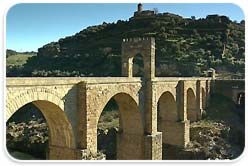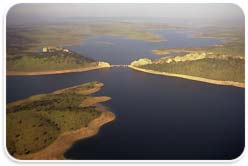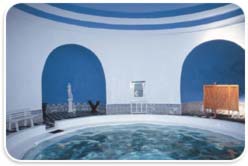Canoeing in the town.
Rivers, Extremadura’s living arms. |
|
| Extremadura has more artificial channels than any other region in Spain. The Lakeland area of Zona de los Lagos is one of the most beautiful regions in the country. The Guadiana River offers the fantastic opportunity to go canoeing. Enthusiasts of this sport can enjoy it upon request in Badajoz. |
|
|

|
|
|
 |
| The bridge of Alcantara. The Roman Bridge was constructed by Emperor Trajan in 104 before Christ. It is located some few metres from the artificial lake Embalse de Alcantara. That lake is longest of Spain. |
|
|
 |
| Embalse de Oriana. This artificial channel i s recorded together with the German lakes Ammer- and Chiemsee as one of the worldwide most important wetland areas. This record liste is a part of the Ramsar convention. |
|
|
 |
| The thermae of Alange. The thermae dated from Roman times. Their water have medicinal effect and are used for healing diseases like nervous affection, arthrosis and rheumatism. |
|
|
|
|
|
|
The Guadiana River is 740km long; it flows near the Tajo and Duero, the third largest river of the Iberian Peninsula, and mostly through Extremadura. The Guadiana forms one of the principal axes of the region, where the towns Mérida and Badajoz are located. In the west of the region through the large lowlands its course is low, and in the east where there is more space, its flow adjusts its form to the landscape. It is divided there into three artificial channels: the Embalse de Cijara, in the west the Embalse de Garcia de Sola and just behind the Embalse de Orellana. The “Zona de los Lagos” is a veritable paradise for nature lovers and water sports enthusiasts. Fishing, swimming, sailing and canoeing can be practiced with pleasure. The Cijara is for sure the wildest and most romantic artificial channel of the Lakeland area. The nature reserve, which surrounds the lake and has the same appellation, is home to a great number of wildlife stocks. The Cijara and the other lakes offer to visitors many opportunities for various activities in their leisure time. Opportunities to relax are offered by the several natural swimming pools, whereas canoeing or climbing the hills around the lake are more for the adventurous. Sailers and windsurfers indulge their passion, especially in the Orellena Lake.
Boat tours enjoy great popularity and are now sponsored by the government. In Badajoz more landing places have recently been created in the Guadiana in order to offer the residents and tourists more leisure activities, especially because the lake is appropriate for longer tours. In Mérida canoe tours across the Roman city are the biggest attraction, however when it is very hot people go to the small lake Proserpina to the north of Mérida during the weekend. They can also canoe and swim there.
Of both Extremadura’s rivers, the Tajo is the most convenient for water sports. It flows through the national park of Monfragüe and through the long lake Embalse de Alcántara, and at its end rises to the ancient Roman bridge. It is possible to canoe the all way, experiencing a magnificent and fantastic journey. You can also reach the Puente Romano when canoeing from the Rio Alagón, the northern tributary of the Tajo River into the Alcantara Lake. The Alcantara Lake and its tributaries flow across the Dehesa plains and canyons too. At some precipices you can see raptors such as griffon vultures, which are nesting on the cliff.
The water of these lakes and rivers is beneficial not only to sport but also to health. At the Alange Lake, which is fed by the Guadiana, stands an authentic Roman bath house. The Extremeños handle this ancient bath house as they do any other ancient building of the region. The licensed bath house is still at the same place the Roman thermae used to be 2000 years ago. Two of the ancient baths have been restored by architects. The memorial stone dedicated to the Goddess Juno still stands within the bath house. According to the legend, she healed a young Roman woman of a serious disease in the bath house of Alange. Is this not a good reason to test the medicinal benefit of this water on oneself?
|
|
|